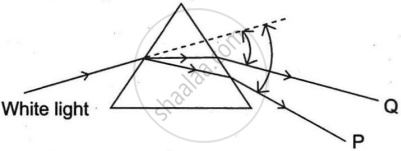Advertisements
Advertisements
प्रश्न
A glass prism is able to produce the spectrum when white light passes through it, but a glass slab doesn’t produce any spectrum. Explain why it is so.
उत्तर
The two faces of a glass prism are at an angle (angle of prism) with each other. Therefore, the angle of incidence and the angle of emergence of a light ray become different in the case of a prism. Therefore, when white light gets dispersed after entering a prism, its component colours spread more after refracting through the opposite face of the prism.
In the case of a glass slab, the two opposite faces of the slab are parallel to each other. Therefore, the angle of incidence and the angle of emergence of a light ray remain the same for a glass slab. Therefore, the dispersed light rays combine to form white light after refracting through the second face of the glass slab.
APPEARS IN
संबंधित प्रश्न
State the cause of dispersion of white light passing through a glass prism. How did Newton show that white light of sun contains seven colours using two identical glass prisms. Draw a ray diagram to show the path of light when two identical glass prisms are arranged together in inverted position with respect to each other and a narrow beam of white light is allowed to fall obliquely on one of the focus of the first prism.
In the figure given alongside, a narrow beam of white light is shown to pass through a triangular glass prism. After passing through the prism, it produces a spectrum YX on the screen.
State the colour seen (i) at X, and (ii) at Y.
How could you show that the colours of the spectrum combine to give white light?
The colour of white light which is deviated the maximum on passing through the glass prism is:
(a) blue
(b) indigo
(c) red
(d) orange
Out of the following, the colour of light having the maximum wavelength is:
(a) violet
(b) indigo
(c) green
(d) orange
The splitting of white light into its constituent colours is called .............
You are given a disc divided into seven sectors with colours violet, indigo, blue, green, yellow, orange and red in them. What would be its colour when it is rotated rapidly?
When a white light ray falls on a prism, the ray at its first surface suffers ______.
In the following diagram, the correctly marked angles are
(A) All
(B) Only ∠i and ∠A
(C) ∠i, ∠r and ∠A
(D) ∠i, ∠A and ∠D
In the following diagram showing dispersion of white light by a glass prism, the colours 'P' and 'Q’ respectively are:

